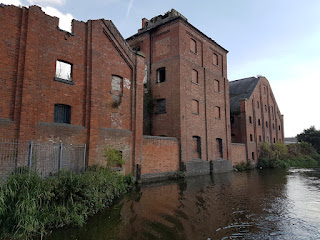Today's Canals - Birmingham Main Line 9woverhampton level). Titford
The weather today was fantastic, warm and bright sunshine, almost unseasonably warm (although the overnight chill took an hour or so to warm up)
We were a little slow getting away as we again do not have too challenging a target for the day - but a little more than the last three! At least we will have to remember how to work locks. The overnight mooring was pretty quiet and few towpath users once it turned dark.
Around ten minutes later we were entering Coseley Gunnel, one of the largest bores on the network, along with Netherton it has a towpath each side. This alignment was not part of the original Birmingham to Wolverhampton canal which was built around 1770 by James Brindley using the contour techniques that were well tried and tested at the time. This did mean that boats took longer than they hoped as they meandered around hills and valleys avoiding locks, tunnels, cuttings and embankments. by the 1830s everyone wanted something better and new techniques had been developed which allowed Thomas Telford, here and elsewhere, to create more direct routes. He was employed to straighten the Birmingham canal as much as possible and Coseley was one of the more ambitious elements of his work. Preparatory work started in 1829 but it was 8 years before it opened to traffic. It is 329 metres in length.
A large site, once a lot of small coal mines and brick works is gradually being prepared for new development but it does seem to involve a very large amount of movement of material. No doubt there is quite a bit of decontamination to be done. We researched this site in 2016 (see here) and the plans that we linked to then have since been abandoned (link broken). A new report last year suggests that, after several schemes had been given planning consent but never started work, a new scheme is now underway. We shall see!
At Tipton Junction we turned down the short branch to the start of the Dudley Tunnel as we wanted to use the service facilities there. We turned the boat under Browns Bridge, part of the Black Country Living Museum.
After the usual round of filling and emptying we returned to the Old Main Line via the narrows which sits beside a chemical works that specialises in products derived from paraffin wax emulsions, many of which are in the pharmaceutical and personal care businesses but also the only producer of a product that forms part of communication and high energy cables.
Our photos from previous visits show Coneygree Railway Bridge still intact but the line apparently unused. Now there now is work in progress, the bridge deck has been removed, and will latter be replaced by a new structure as part of a new extension to the Metro network. It is hoped that it will stat to carry passengers in 2023.
With the aid of Waterway Routes and old OS Maps we tried to spot where the old contour canal was straightened by Telford, leaving a number of small loops which gradually closed and were bulk over. Often the only clue is in changes to the brickwork on the edge of the towpath.
The canal continues underneath the elevated motorway - here we were looking for a right turn onto the Titford Canal.
We made our way up the first three locks quite easily - save for a large branch that wanted to prevent the top gate closing after us but we fished it out of the way! (Sorry no photo evidence!)
However, the top three took a little more effort as both the final two short pounds were quite low and we had to run water down until the boat could just scrape over the cills.
Finally as we were making it out of the top lock, alongside the former pumphouse, a kindly chap came across from the boat next to the entrance to chat and he said that we would be welcome to moor for the night in the Tat Branch Arm (that joins above the top lock) although we would have to double up alongside a couple of work boats. He also told us that the Titford Pools had been dredged last year and it is safe to navigate to the end of both with room to turn. But he did warn us that the canal itself had not been cleared and that we might scrape along the bottom at times.
All of this information turned out to be spot on and were able to make a full visit to the pools in confidence. When we first came here the lack of depth meant that boats were recommended not to go beyond the final turning point at the entrance and in 2016 we were rather tentative and saw most by foot from the towpath.
Alongside the towpath at the start of the pools is a sculpture by the same artist, Luke Perry, as an older one we saw some days ago on the Daw End Canal. It is a tribute to the rock drillers who worked up ladders in pre-mechanised deep seam coal mines, in very dangerous conditions. Luke Perry has created over 30 sculptures which are installed alongside parts if Birmingham's canals.
After exploring the pools we returned back to the Pumphouse for the night. Along the way we were dismayed to see that the former Langley Maltings is getting even more derelict - when we came here in 2016 it was already a sorry sight. Some of its history can be found here. The structure is now listed and the local council have refused permission for it to be demolished. However, no developer is yet prepared to take it on. Heritage England insist that it could be re-used.

















No comments:
Post a Comment